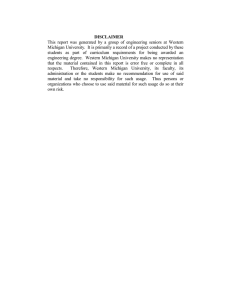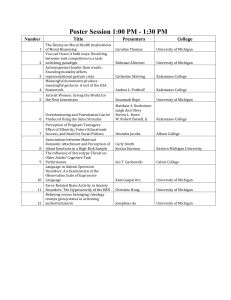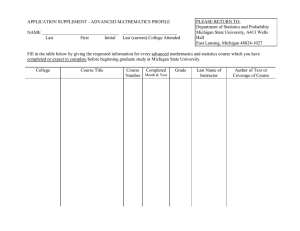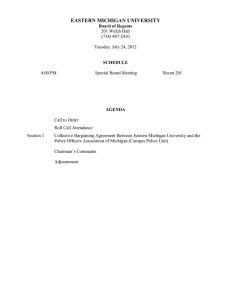Preparing for EC 200x Session I Rita Caso Jeff Froyd
advertisement
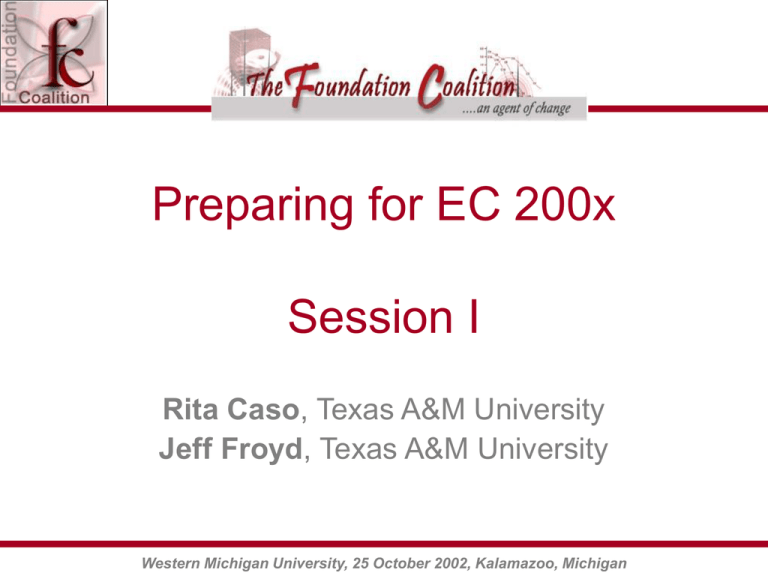
Preparing for EC 200x Session I Rita Caso, Texas A&M University Jeff Froyd, Texas A&M University Western Michigan University, 25 October 2002, Kalamazoo, Michigan Workshop Presenters • Jeff Froyd, Director of Academic Development – Educational Achievement Division, College of Engineering, Texas A&M University – Project Director, Foundation Coalition • Rita Caso, Director of Assessment & Evaluation – Educational Achievement Division, College of Engineering, Texas A&M University Western Michigan University, 25 October 2002, Kalamazoo, Michigan Overview I 8:30 – 10:00 AM –Overview –Concept Inventories for Engineering Science –Surveys of Self-Reported Mastery III 1:00 – 2:30 PM – Soft Skills Assessment • Communication • Teaming Time – 90 minutes Time – 90 minutes II 10:30 – 12:00 Noon – Soft Skills Assessment • Lifelong Learning IV 3:00 – 5:30 PM – Rubrics for Open-Ended Assessment • Design • Problem Solving Time – 150 minutes Time – 90 minutes Western Michigan University, 25 October 2002, Kalamazoo, Michigan All Workshop Sessions Feature: • Background information about assessment instruments and methods for selected ABET “a – k” criteria • Instruments developed or adopted by FC institutions • Hands-on practice using instruments or methods • Information about developing and adapting instruments and methods for tailored application Western Michigan University, 25 October 2002, Kalamazoo, Michigan Starting Point How might you prepare a selfstudy report? Rita Caso, Texas A&M University Jeff Froyd, Texas A&M University Western Michigan University, 25 October 2002, Kalamazoo, Michigan EC 200x General Criteria • Criterion 1: Students • Criterion 2: Program Educational Objectives • Criterion 3: Program Outcomes and Assessment • Criterion 4: Professional Component • Criterion 5: Faculty • Criterion 6: Facilities • Criterion 7: Institutional Support and Financial Resources Western Michigan University, 25 October 2002, Kalamazoo, Michigan EC 200x Criteria 1, 2, and 3 • General Guideline No. 1: Assessment data are necessary, but not sufficient. • General Guideline No. 2: Decisions based on assessment data are necessary, but not sufficient. • General Guideline No. 3: Processes that lead to decisions based on assessment data are necessary and sufficient. Western Michigan University, 25 October 2002, Kalamazoo, Michigan Criterion 1: Students • Program Requirements – – – – Evaluate incoming students Advise current students Evaluate and enforce program requirements Evaluate success in meeting program outcomes (see Criterion 3) • Exceptional Cases – Check compliance with policies for the acceptance of transfer students – Check compliance with validation of courses taken for credit elsewhere. Western Michigan University, 25 October 2002, Kalamazoo, Michigan Criterion 1. Students • The quality and performance of the students and graduates are important considerations in the evaluation of an engineering program. The institution must evaluate, advise, and monitor students to determine its success in meeting program objectives. • The institution must have and enforce policies for the acceptance of transfer students and for the validation of courses taken for credit elsewhere. The institution must also have and enforce procedures to assure that all students meet all program requirements. Western Michigan University, 25 October 2002, Kalamazoo, Michigan Criterion 1: Students • Describe the processes through which entering students are selected. • Describe the processes through which student progress is monitored and students are informed about their progress. • Describe the processes for decisions about course substitutions. Evaluate affect on criterion 4. • Describe the processes for decisions about transferring credit for courses taken at another school. • Describe the processes for decisions about transfer students and credit for their courses. • Make sure transcripts are consistent with process descriptions. Western Michigan University, 25 October 2002, Kalamazoo, Michigan Criterion 2. Program Educational Objectives • Each engineering program must have: – (a) detailed published educational objectives – (b) a process that involves the program's various constituencies to determine and periodically evaluate the educational objectives – (c) a curriculum and processes that ensure the achievement of these objectives – (d) a system of ongoing evaluation that demonstrates achievement of these objectives and uses the results to improve the effectiveness of the program. Western Michigan University, 25 October 2002, Kalamazoo, Michigan Criterion 2. Program Educational Objectives • Each engineering program for which an institution seeks accreditation or reaccreditation must have in place: – (a) detailed published educational objectives that are consistent with the mission of the institution and these criteria – (b) a process based on the needs of the program's various constituencies in which the objectives are determined and periodically evaluated – (c) a curriculum and processes that ensure the achievement of these objectives – (d) a system of ongoing evaluation that demonstrates achievement of these objectives and uses the results to improve the effectiveness of the program. Western Michigan University, 25 October 2002, Kalamazoo, Michigan Criterion 2. Program Educational Objectives • State program educational objectives • Indicate where the educational objectives are published • Describe program constituencies • Describe the process through which the educational objectives were developed and how the various constituencies were involved • Describe the process through which the educational objectives will be reviewed. • For each educational objective describe the level of achievement and present a reasoned argument (with data) that supports the conclusion. Western Michigan University, 25 October 2002, Kalamazoo, Michigan Criterion 3. Program Outcomes and Assessment • Student Outcomes: a-k • Assessment Process – Documented results • Continuous Improvement – Evidence must be given that the results are applied to the further development and improvement of the program. Western Michigan University, 25 October 2002, Kalamazoo, Michigan EC 200x Program Outcomes (a) an ability to apply knowledge of mathematics, science, and engineering (b) an ability to design and conduct experiments, as well as to analyze and interpret data (c) an ability to design a system, component, or process to meet desired needs (d) an ability to function on multi-disciplinary teams (e) an ability to identify, formulate, and solve engineering problems (f) an understanding of professional and ethical responsibility (g) an ability to communicate effectively (h) the broad education necessary to understand the impact of engineering solutions in a global and societal context (i) a recognition of the need for, and an ability to engage in life-long learning (j) a knowledge of contemporary issues (k) an ability to use the techniques, skills, and modern engineering tools necessary for engineering practice. Western Michigan University, 25 October 2002, Kalamazoo, Michigan Criterion 3. Program Outcomes and Assessment • Engineering programs must demonstrate that their graduates have: – – – – – – – – – – – • (a) an ability to apply knowledge of mathematics, science, and engineering (b) an ability to design and conduct experiments, as well as to analyze and interpret data (c) an ability to design a system, component, or process to meet desired needs (d) an ability to function on multi-disciplinary teams (e) an ability to identify, formulate, and solve engineering problems (f) an understanding of professional and ethical responsibility (g) an ability to communicate effectively (h) the broad education necessary to understand the impact of engineering solutions in a global and societal context (i) a recognition of the need for, and an ability to engage in life-long learning (j) a knowledge of contemporary issues (k) an ability to use the techniques, skills, and modern engineering tools necessary for engineering practice. Each program must have an assessment process with documented results. Evidence must be given that the results are applied to the further development and improvement of the program. The assessment process must demonstrate that the outcomes important to the mission of the institution and the objectives of the program, including those listed above, are being measured. Evidence that may be used includes, but is not limited to the following: student portfolios, including design projects; nationally-normed subject content examinations; alumni surveys that document professional accomplishments and career development activities; employer surveys; and placement data of graduates. Western Michigan University, 25 October 2002, Kalamazoo, Michigan Criterion 3. Program Outcomes and Assessment • Describe your program (student) outcomes. • Describe the process through which the program outcomes were developed. How were your constituencies involved? • Describe the process through which the program outcomes are reviewed. How are your constituencies involved? Western Michigan University, 25 October 2002, Kalamazoo, Michigan Criterion 3. Program Outcomes and Assessment • For each program outcome – Indicate which person or group of people is responsible – Indicate the expected level of achievement – Describe the process through which the outcome is being evaluated, that is, how do you decide the level to which an outcome is being achieved – Indicate the level to which the outcome is being achieved – Present a reasoned argument (with data) the supports your conclusion about the level of achievement Western Michigan University, 25 October 2002, Kalamazoo, Michigan Criterion 3. Program Outcomes and Assessment • Continuous Improvement – At a particular point in time how do you identify which program outcomes have the highest priority in terms of improvement? – In preparing the visit report provide examples of program outcomes that had the highest priority in terms of improvement? – For each program outcome targeted for improvement, describe the changes which have been made to effect improvement? – For each program outcome, describe the results of the changes in terms of possible changes in the level of achievement Western Michigan University, 25 October 2002, Kalamazoo, Michigan Criterion 3. Program Outcomes and Assessment • • • • • Objective-Outcome Matrix Outcome-(a-k) Matrix Objective-Course Matrix Outcome-Course Matrix Process Diagrams Western Michigan University, 25 October 2002, Kalamazoo, Michigan Assessment Methods 1. Commercial NormReferenced, Standardized Examinations 2. Locally Developed Examinations 3. Oral Examinations 4. Performance Appraisals 5. Simulations 6. Written Surveys and Questionnaires 7. Exit Interviews and Other Interviews 8. 9. 10. 11. 12. 13. 14. 15. Third Party Reports Behavioral Observations External Examiners Archival Records Portfolios Classroom Research “Stone” Courses Focus Groups Prus, J., Johnson, R., (1994) Assessment & Testing, Myths & Realities, New Directions for Community Colleges, No. 88, Winter 1994 Western Michigan University, 25 October 2002, Kalamazoo, Michigan Sources of Assessment Data • Employer reports on co-op and/or intern students • Work products from major design experiences • Graded material (not necessarily course grades) aligned with outcomes • MORE Western Michigan University, 25 October 2002, Kalamazoo, Michigan Criterion 4. Professional Component • Major design experience – Based on the knowledge and skills acquired in earlier course work – Incorporates most of the following considerations: economic; environmental; sustainability; manufacturability; ethical; health and safety; social; and political. • Course requirements: – (a) one year of college level mathematics and basic sciences – (b) one and one-half years of engineering topics, that is, engineering sciences and engineering design – (c) a general education component that complements the technical content of the curriculum and is consistent with the program and institution objectives. Western Michigan University, 25 October 2002, Kalamazoo, Michigan Criterion 4. Professional Component • The professional component requirements specify subject areas appropriate to engineering but do not prescribe specific courses. The engineering faculty must assure that the program curriculum devotes adequate attention and time to each component, consistent with the objectives of the program and institution. Students must be prepared for engineering practice through the curriculum culminating in a major design experience based on the knowledge and skills acquired in earlier course work and incorporating engineering standards and realistic constraints that include most of the following considerations: economic; environmental; sustainability; manufacturability; ethical; health and safety; social; and political. The professional component must include: – (a) one year of a combination of college level mathematics and basic sciences (some with experimental experience) appropriate to the discipline – (b) one and one-half years of engineering topics, consisting of engineering sciences and engineering design appropriate to the student's field of study – (c) a general education component that complements the technical content of the curriculum and is consistent with the program and institution objectives. Western Michigan University, 25 October 2002, Kalamazoo, Michigan Criterion 4. Professional Component • Major Design Experience – Overall description – Describe how most of the factors are incorporated into the major design experience – Provide examples of student work that show design process, quality outcomes, and understanding of different factors • Course Requirements – Transcript analysis Western Michigan University, 25 October 2002, Kalamazoo, Michigan Criterion 5. Faculty • Sufficient number – – – – – Student-faculty interaction Student advising and counseling University service Professional development Interactions with practitioners • Breath of competence to cover all of the curricular areas of the program. – Education – Experience: engineering, Professional Engineers, teaching, professional societies, etc. – Activity in curricular/pedagogical initiatives – Research activity Western Michigan University, 25 October 2002, Kalamazoo, Michigan Criterion 5. Faculty • The faculty is the heart of any educational program. The faculty must be of sufficient number; and must have the competencies to cover all of the curricular areas of the program. There must be sufficient faculty to accommodate adequate levels of student-faculty interaction, student advising and counseling, university service activities, professional development, and interactions with industrial and professional practitioners, as well as employers of students. • The program faculty must have appropriate qualifications and must have and demonstrate sufficient authority to ensure the proper guidance of the program and to develop and implement processes for the evaluation, assessment, and continuing improvement of the program, its educational objectives and outcomes. The overall competence of the faculty may be judged by such factors as education, diversity of backgrounds, engineering experience, teaching experience, ability to communicate, enthusiasm for developing more effective programs, level of scholarship, participation in professional societies, and registration as Professional Engineers. Western Michigan University, 25 October 2002, Kalamazoo, Michigan Criterion 5. Faculty • Complete the faculty worksheet • Include a brief paragraph on each faculty member in the selfstudy. Western Michigan University, 25 October 2002, Kalamazoo, Michigan Criterion 6. Facilities • Classrooms – Number and size • Laboratories – Number and size – Evidence of continued maintenance and improvement • Equipment, including computers – Inventory – Evidence of continued maintenance and improvement Western Michigan University, 25 October 2002, Kalamazoo, Michigan Criterion 6. Facilities • Classrooms, laboratories, and associated equipment must be adequate to accomplish the program objectives and provide an atmosphere conducive to learning. Appropriate facilities must be available to foster faculty-student interaction and to create a climate that encourages professional development and professional activities. Programs must provide opportunities for students to learn the use of modern engineering tools. Computing and information infrastructures must be in place to support the scholarly activities of the students and faculty and the educational objectives of the institution. Western Michigan University, 25 October 2002, Kalamazoo, Michigan Criterion 6. Facilities • Describe classrooms • Describe each laboratory and how it has been updated • Describe equipment and how it has been updated. Western Michigan University, 25 October 2002, Kalamazoo, Michigan Criterion 7. Institutional Support and Financial Resources • Financial resources – Attract, retain, support well-qualified faculty – Acquire, maintain, operate facilities and equipment • Institutional support – Adequate service personnel – Adequate institutional services • Constructive leadership Western Michigan University, 25 October 2002, Kalamazoo, Michigan Criterion 7. Institutional Support and Financial Resources • Institutional support, financial resources, and constructive leadership must be adequate to assure the quality and continuity of the engineering program. Resources must be sufficient to attract, retain, and provide for the continued professional development of a well-qualified faculty. Resources also must be sufficient to acquire, maintain, and operate facilities and equipment appropriate for the engineering program. In addition, support personnel and institutional services must be adequate to meet program needs. Western Michigan University, 25 October 2002, Kalamazoo, Michigan Criterion 7. Institutional Support and Financial Resources • Describe available financial resources and how they have been used • Describe professional development opportunities • Describe support personnel • Describe institutional services • Describe relationship with larger campus community Western Michigan University, 25 October 2002, Kalamazoo, Michigan Session I: Assessing Science, Math and Engineering Content Knowledge • Engineering Concept Inventories – Description – Development – Contact and Field Testing Information • Surveys – Perceptions of Engineering Science Mastery – Attitudes towards Engineering Science Subjects • Examples • Uses Western Michigan University, 25 October 2002, Kalamazoo, Michigan Concept Inventories: Description • Assess intuition/understanding of fundamental concepts as opposed to computational skill • Potential Application – Assess the effectiveness pedagogical techniques or curriculum reform efforts. – Administer a standardized conceptual exam as pre-test and a post-test and compute gain during the semester. • Potential Application – Assess understanding of concepts as a prelude to applying knowledge of math, science and engineering. – Administer a standardized conceptual exam in the senior year. Western Michigan University, 25 October 2002, Kalamazoo, Michigan Concept Inventories: Description • Motivated by the Force Concept Inventory created by Halloun and Hestenes and its impact on physics education, the Foundation Coalition is working to create concept inventories for specific engineering disciplines. • Thermodynamics • Electromagnetics • Strength of Materials • Signals and Systems • Fluid Mechanics • Circuits • Materials Western Michigan University, 25 October 2002, Kalamazoo, Michigan Force Concept Inventory (FCI) • Designed to measure conceptual, not computational, understanding of Newtonian Mechanics. – The FCI is a multiple-choice test that assess’ student understanding of basic concepts in Newtonian physics. – It can be used for several different purposes, but the most important one is to evaluate the effectiveness of instruction. • Questions focus on intuitive comprehension independent of knowledge of the terminology or numerical modeling. Western Michigan University, 25 October 2002, Kalamazoo, Michigan Concept Inventories • http://www.foundationcoalition.org/concept Western Michigan University, 25 October 2002, Kalamazoo, Michigan Signals and Systems Concept Inventory http://ece.gmu.edu/%7Ekwage/research/ssci/ • Continuous-Time Signals and Systems Concept Inventory (CT-SSCI) • Discrete-Time Signals and Systems Concept Inventory (CT-SSCI) • John Buck – University of Massachusetts Dartmouth – JBuck@umassd.edu • Kathleen Wage – George Mason University – kwage@gmu.edu Western Michigan University, 25 October 2002, Kalamazoo, Michigan Signals and Systems Concept Inventory http://ece.gmu.edu/%7Ekwage/research/ssci/ • Consider a real, continuous-time signal x(t), which contains two narrowband pulses (windowed sinusoids). Figures 1(a) and 1(b) below depict x(t) and its Fourier transform magnitude |X(jω)|. The signal x(t) is the input to a real LTI filter with the frequency response magnitude |H(jω)|, shown in Figure 1(c). Figure 1(d) on the next page shows four possible output signals ya(t) through yd(t). Which of these four signals could be the output of the filter in • (a) ya(t) (b) yb(t) (c) yc(t) (d) yd(t) ? • Pictures and graphs were then shown below. Western Michigan University, 25 October 2002, Kalamazoo, Michigan Thermodynamics Concept Inventory (TCI) • Clark Midkiff (principal contact) – University of Alabama – cmidkiff@bama.ua.edu • Thomas A. Litzinger – Pennsylvania State University – TAL2@psu.edu • Donovan L. Evans – Arizona State University – devans@asu.edu Western Michigan University, 25 October 2002, Kalamazoo, Michigan Electromagnetics Concept Inventory (ECI) • EMCI-Fields (electro and magnetostatic, and time-varying EM fields) • EMCI-Waves (uniform plane waves, transmission lines, waveguides, and antennas) • EMCI-Fields & Waves (a combination of the first two exams) • Branislav Notaros – University of Massachusetts Dartmouth – mailto:bnotaros@umassd.edu Western Michigan University, 25 October 2002, Kalamazoo, Michigan Strength of Materials Concept Inventory (SoMCI) • Principal Developers – Jim Richardson • University of Alabama • jrichardson@bama.ua.edu – Jim Morgan • Texas A&M University • jim-morgan@tamu.edu Western Michigan University, 25 October 2002, Kalamazoo, Michigan Circuits Concept Inventory • Principal Developers – Robert Helgeland • University of Massachusetts-Dartmouth • rhelgeland@umassd.edu – David Rancour • University of Massachusetts-Dartmouth • drancour@umassd.edu • Circuit Theory is usually the first course in the major for electrical engineering and computer engineering students. Part One of the Circuits Concept Inventory (CCI) will measure a student’s conceptual understanding of the basic properties of electricity, circuit components and linear time-invariant networks (DC and AC). Part Two will address frequency domain concepts, coupled inductors, convolution, impulse response, and transform techniques. Western Michigan University, 25 October 2002, Kalamazoo, Michigan Materials Concept Inventory • Principal Developers – Richard Griffin • Texas A&M University • rgriffin@mengr.tamu.edu – Steve Krause • Arizona State University • skrause@asu.edu • An instrument is being developed to measure misconceptions on materials structure, processing, and properties. It will be used to examine student knowledge before and after teaching introductory materials engineering courses that are required by many engineering colleges. Considerable research shows that prior misconceptions are strongly held even in the face of good instruction. A better understanding of "prior knowledge" can help instructors improve instruction in their classes. Western Michigan University, 25 October 2002, Kalamazoo, Michigan Fluid Mechanics Concept Inventory (FCMI) • Principal Developers – John Mitchell • University of Wisconsin • mitchell@engr.wisc.edu – Jay Martin • University of Wisconsin • martin@engr.wisc.edu – Ty Newell • University of Illinois at Urbana-Champaign • t-newell@uiuc.edu • The goal of the Fluids Mechanics Concept Inventory (FMCI) is to establish a common base of fluids concepts and provide instruments that could be used by faculty to evaluate the degree to which students in a given program have mastered those concepts. The inventory would be conducted in each of the fluids classes at the start of the semester to assess the knowledge of entering students and at the end of the semester to assess whether students have mastered the necessary concepts. An outcome of conducting the inventory might be modifications to the curriculum and courses to ensure that students obtain the necessary understanding of the basic concepts. Western Michigan University, 25 October 2002, Kalamazoo, Michigan Surveys • Perceptions of Engineering Science Mastery • Example: For each of the following topics, please use the scales below to RATE how well you feel you have mastered the topic on a scale of 1-5, 1 being very well, and 5 being very poorly. – – – – – Atomic bonding in solid materials Crystal structures in solid materials Polymers – structures and properties Materials strengthening methods Materials selection issues Western Michigan University, 25 October 2002, Kalamazoo, Michigan Surveys • Attitudes Towards Engineering Science Subjects • Example: On a scale of 1-5, please rate your agreement with the following statements. ( SA =Strongly Agree, A=Agree, N=Neutral, D=Disagree, SD=Strongly Disagree) – – – – – – – Modern technology is too difficult for me to understand Technology helps more than it hurts society Technology dehumanizes people Those who can use technology will dominate society I like technologically complex machines Modern work requires skills in teamwork Technology makes writing obsolete Western Michigan University, 25 October 2002, Kalamazoo, Michigan Summary: Session 1 • Preparing a EC 200x self-study • Student Outcome (a): Apply math, science, and engineering – Engineering Science Concept Inventories – Survey: Perceptions of Engineering Science Mastery – Survey: Attitudes towards Engineering Science Western Michigan University, 25 October 2002, Kalamazoo, Michigan
